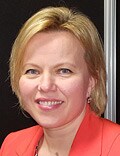LOS ANGELES — Longer-term use of the antisense oligonucleotide nusinersen (Spinraza, Biogen) is both safe and effective in children with infantile-onset spinal muscular atrophy (SMA), new research suggests.
Interim results from the open-label SHINE study of 89 patients who were transitioned from the phase 3 ENDEAR trial were presented here during the Emerging Science Session at the American Academy of Neurology (AAN) 2018 Annual Meeting.
The participants who received intrathecal nusinersen in both the original and new trials had continued improvements in motor function, such as sitting and head control, and in event-free survival (EFS) time, which measured death or permanent ventilation.
Mean EFS time was also significantly greater for these patients than for those who underwent a sham procedure in ENDEAR and then initiated nusinersen treatment in SHINE (73 weeks vs 23 weeks, respectively).
Still, the latter group showed new improvements in motor function after switching to the study drug.
Although 83 patients in SHINE had some type of adverse event (AE), there were no treatment-related serious AEs. The most commonly reported AEs were pyrexia and upper respiratory tract infection.
“Because I work with a lot of families of patients with spinal muscular atrophy, it makes me happy to see that this medication continues to be safe,” lead author, Diana Castro, MD, Department of Pediatrics, Neurology and Neurotherapeutics at University of Texas Southwestern Medical Center, Dallas, told Medscape Medical News.

Dr Diana Castro
She was also pleased with the efficacy results. “The natural history of these patients is laying down — they will be paralyzed from head to toe and able to only move their eyes. But now patients are doing things that we were not expecting years ago,” said Castro.
She added that “if we can just diagnose and treat these babies early, hopefully we can improve their outcomes.”
First Drug Approved for SMA
Nusinersen was approved by the US Food and Drug Administration (FDA) in December 2016 for the treatment of children and adults with SMA, and was the first drug to receive approval for this condition. It is administered by injection into cerebrospinal fluid.
According to the FDA, the recommended dosage is 12 mg per administration. Treatment should be initiated with four loading doses, with a maintenance dose administered every 4 months afterward.
As reported by Medscape Medical News, results from the phase 3 CHERISH trial of 126 children with SMA (aged 2 to 12 years) were presented at last year’s AAN Annual Meeting. Those findings showed that participants who received four doses of the study drug over 9 months had significantly greater improvement scores on the Hammersmith Functional Motor Scale-Expanded than did those who received a sham procedure.
The active-treatment group also had greater improvements in upper-limb function and achieved more new motor milestones.
In ENDEAR, 41% of infants treated with nusinersen had a motor milestone response at an interim analysis and 51% met the outcome at end of study vs 0% of those in the sham control group.
SHINE was created as an open-label extension study for the participants of the CHERISH, ENDEAR, CS12, and CS34 trials. “Nusinersen doses were administered according to the regimen and participant’s cohort from the previous trial,” write the investigators.
The data presented at this year’s Emerging Science Session were of 89 patients transitioned from ENDEAR, which assessed infantile-onset SMA — those “most likely to develop SMA Type 1,” the investigators note. Of these, 65 had previously received the study drug and 24 had acted as the sham control. The cutoff date for this interim analysis was June 30, 2017.
SHINE’s primary endpoint was safety/tolerability. Secondary outcomes included achievement of motor milestones on Section 2 of the Hammersmith Infant Neurological Examination (HINE-2) and EFS time.
“Meaningful” Outcomes
Among the group members receiving continued treatment with nusinersen, 60 reported an AE compared with 23 members of the sham control group transitioned to the study drug. The number of patients in each group reporting serious AEs were 39 and 13, respectively. But, as mentioned earlier, none of the AEs were found to be treatment related. Still, 4 and 2 members of each group, respectively, discontinued treatment because of an AE.
The mean change in HINE-2 total score from start of nusinersen treatment to last observed visit was greater in the participants who received the study drug in both ENDEAR and SHINE than in those who received the sham procedure in ENDEAR and then the study drug in SHINE:
-
First group: mean change, 5.8 (95% confidence interval [CI], 4.58 – 7.04);
-
Second group: mean change, 1.1 (95% CI, 0.20 – 1.90).
In the patients who continued treatment, 28% achieved full head control and 15% achieved independent sitting as their highest motor milestone.
Mean time to death or permanent ventilation was 73.0 weeks (95% CI, 36.3 weeks to not applicable) vs 22.6 weeks (95% CI, 13.6 to 31.3 weeks) for the two treatment groups, respectively.
Among those who initiated nusinersen treatment during SHINE, 58% were alive without permanent ventilation at the analysis cutoff date.
Castro noted that around age 3 to 4 months, patients with infantile-onset SMA historically start to see deterioration of upper respiratory function and need to use a ventilation system 24/7.
“The medication is now not letting the patient get to that point where they need full-time ventilation or where they will have multiple events that will put them at a risk of dying. So it’s definitely an improvement,” she said.
“The families are very grateful for everything,” she added. “For example, a kid who was having trouble bringing a spoon to their mouth is now able to start feeding themselves again. These things are very meaningful for the daily activities of these patients.”
The investigators write that further SHINE data analysis “will provide additional information on the long-term safety/tolerability and efficacy of repeated nusinersen doses across multiple SMA populations.”
Reassuring — But Questions Remain
Asked to comment by Medscape Medical News, chair of the meeting’s scientific committee, Natalia S Rost, MD, MPH, director of the Acute Stroke Service at Massachusetts General Hospital and associate professor of neurology at Harvard Medical School, Boston, said that last year’s presentation on nusinersen was a significant breakthrough for a devastating disorder, “and this is a continuation of that.”

Dr Natalia S Rost
Although she said she’s excited about these further positive results, “We’re also fascinated to see development in the field” of other SMA treatments.
“It’ll be interesting to see which will take precedence and how patients will be selected for one therapy over another. Cost will be a factor,” noted Rost.
“This study basically showed us that the kids continue to do well, but they are bound by every 4 months having a spinal injection of the drug, which is extremely expensive. And we don’t know what happens after doing that for 20 years. What are the complications? Could there be inflammatory reaction in the spine and things like that? We don’t know,” she said.
“We are hopeful, although we’ll need to figure out these issues and the costs. But [the new analysis] is reassurance that the nusinersen therapy continues to work,” Rost concluded.
The study was funded by Biogen. Castro has received personal compensation for serving on scientific advisory boards for Marathon and Sarepta and has received research support from Biogen, Sarepta, ReveraGen Biopharma, and FibroGen. Rost has received personal compensation for consulting, serving on a scientific board, speaking, or other activities from Broadview Ventures, Covance Inc, Merck & Co, Omniox, and Sanofi Genzyme and has received personal compensation in an editorial capacity for UpToDate and Current Treatment Options in Cardiovascular Medicine.
American Academy of Neurology (AAN) 2018 Annual Meeting. Emerging Science Session, Talk 003. Presented April 24, 2018.
Follow Deborah Brauser on Twitter: @MedscapeDeb . For more Medscape Neurology news, join us on Facebook and Twitter .
Tidak ada komentar:
Posting Komentar